Projector vs flat panel. Try on an ophthalmologist's robe and find out why size matters
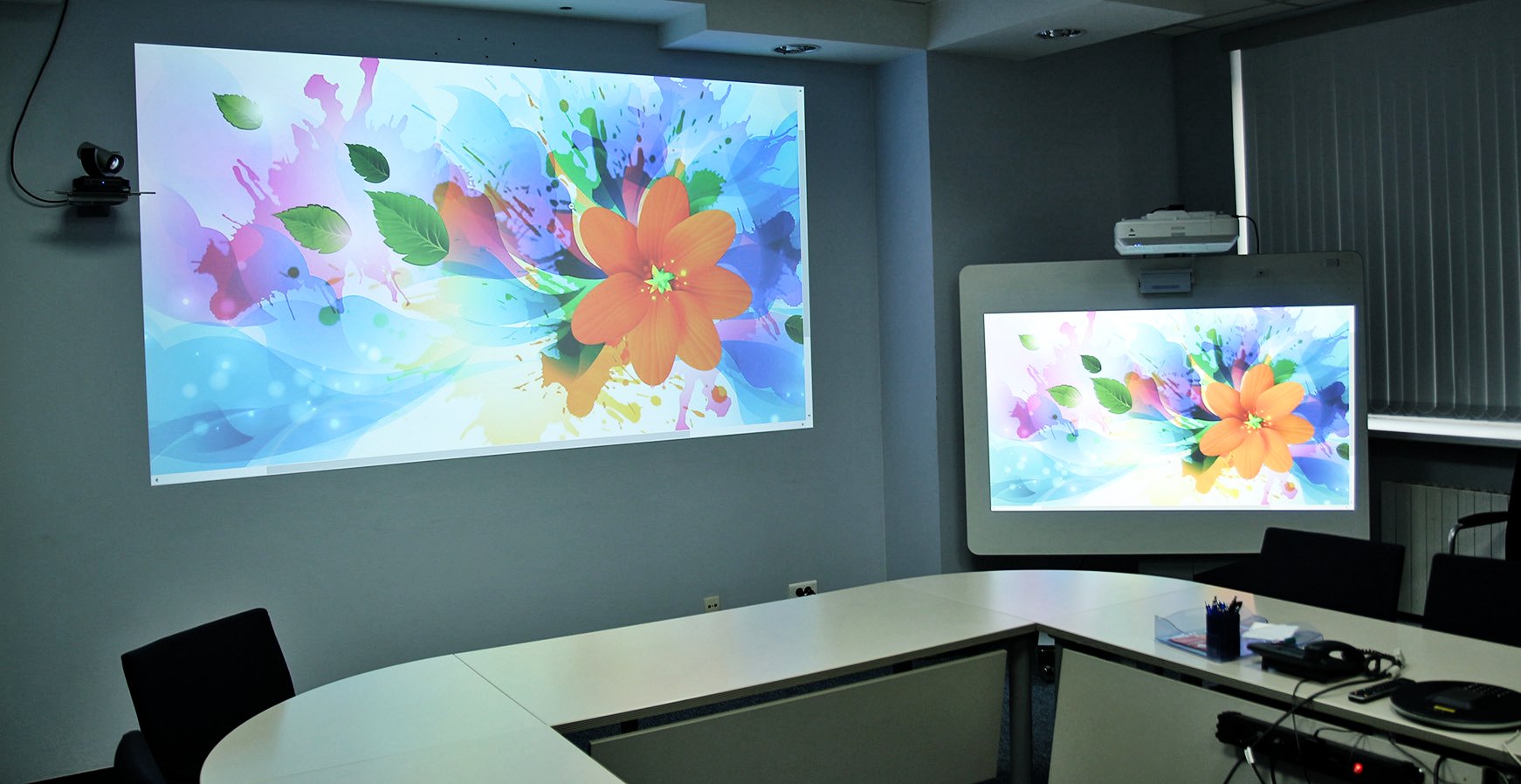
When we say "projector", we mean a large diagonal : 80 inches or more. This is the key advantage of the projector as a display device. This is clear to everyone. In this case, if we are talking about a large diagonal, it is logical that the projectors greatly benefit in price compared to televisions and LCD panels (if they exist at all in the right size).
However, for many, the question: “Does such a large diagonal need to be everywhere?” Remains open. In the case of a home theater, everything is extremely clear - due to the large screen size, we are trying to achieve or exceed the effect of presence or immersion, which is achieved in commercial theaters.
However, projectors are used in other areas - for example, in education and business environment - where you need to show and tell the presentation with the highest quality and intelligible. In addition, at home, the projector can be used not only in a home theater, but also as a replacement for a TV (although these two ways of using the projector are still slightly different).
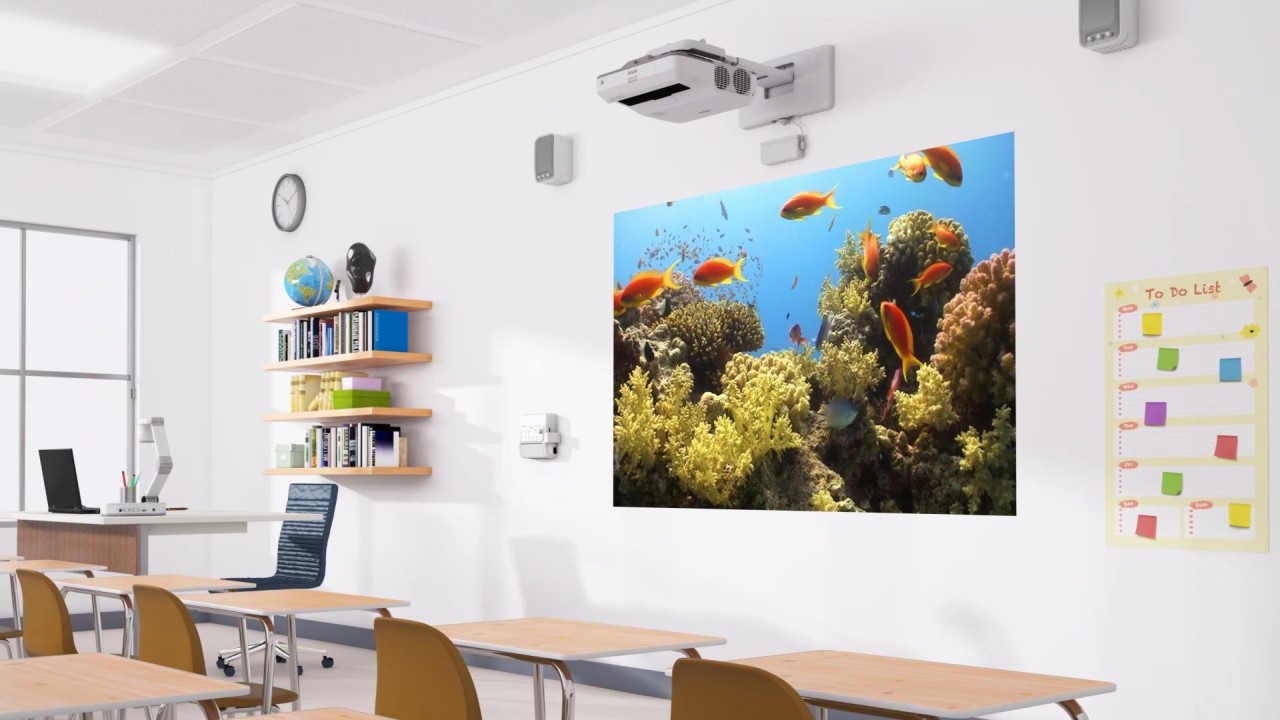
In this publication, I want to talk about two important reasons that make the image of large diagonals the preferred option, first of all, at school, the audience or the office . Both reasons are related to the ability to simultaneously increase the intelligibility of the image and the viewing distance .
Make yourself comfortable and be prepared for the fact that after reading this post, you will want to sit far away from your monitor or replace the tablet with a model with a larger diagonal. If anything, I warned.
View from the last row (reason number 1)
Recently, on Epson.ru, we opened a special section dedicated to the advantages of large diagonals with an elegant slogan "Size does matter . "
This brochure from the page clearly demonstrates how a 60 or 70-inch LCD panel looks compared to a 100-inch image of the projector from a distance of 3 and 6 meters:

The distance from the viewer to the screen of 6 meters can be found quite often in large meeting rooms and classrooms and classrooms. This room is in our office (more on this below). The mentioned brochure when reading will, of course, be perceived differently on screens with different resolutions and with different settings for the scale of the document. The most important thing is that with certain scale settings, the text on the 60-inch screen will no longer be distinguishable , as in this demonstration:
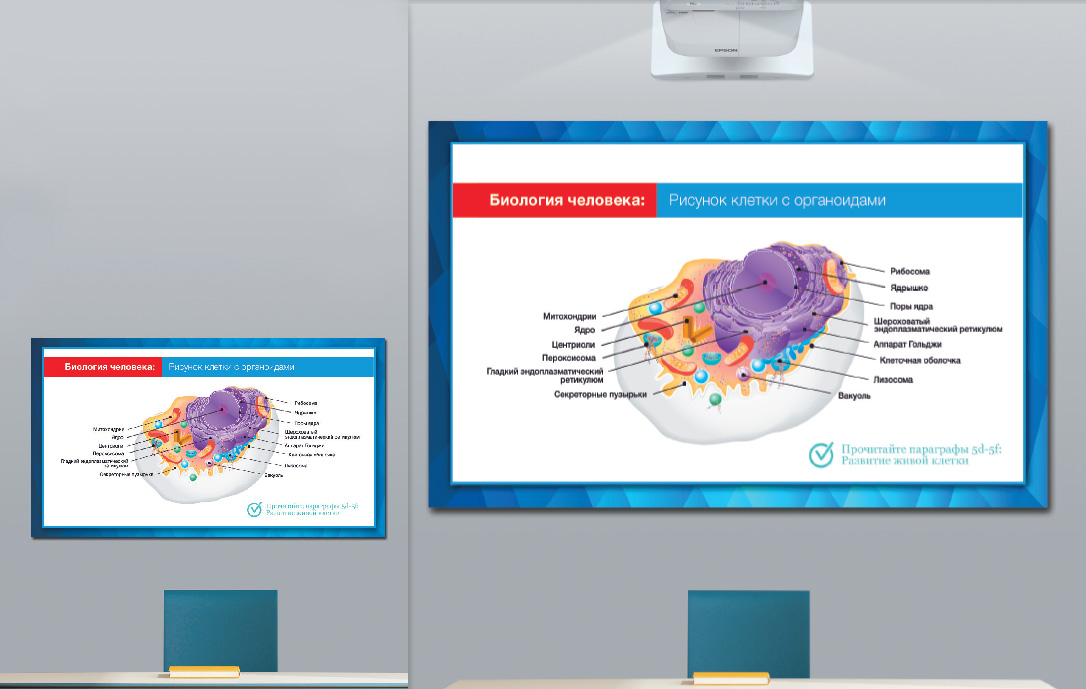
This example is designed to correspond as closely as possible to reality: at a certain distance from the viewer, a diagonal of 100 inches will ensure sufficient intelligibility of the text, and 60 '' - no longer. However, in the real world one more factor is added that is not mentioned in the brochure - the different visual acuity of the audience .
Simplest experiment
We place a 23-inch monitor at arm's length (~ 65 cm) and move it away from the wall onto which the image with a diagonal of 123 inches is projected (figure below) until the images match the visibility range (field of view) they occupy. This will happen when the viewer is 2.66 meters away from the wall.
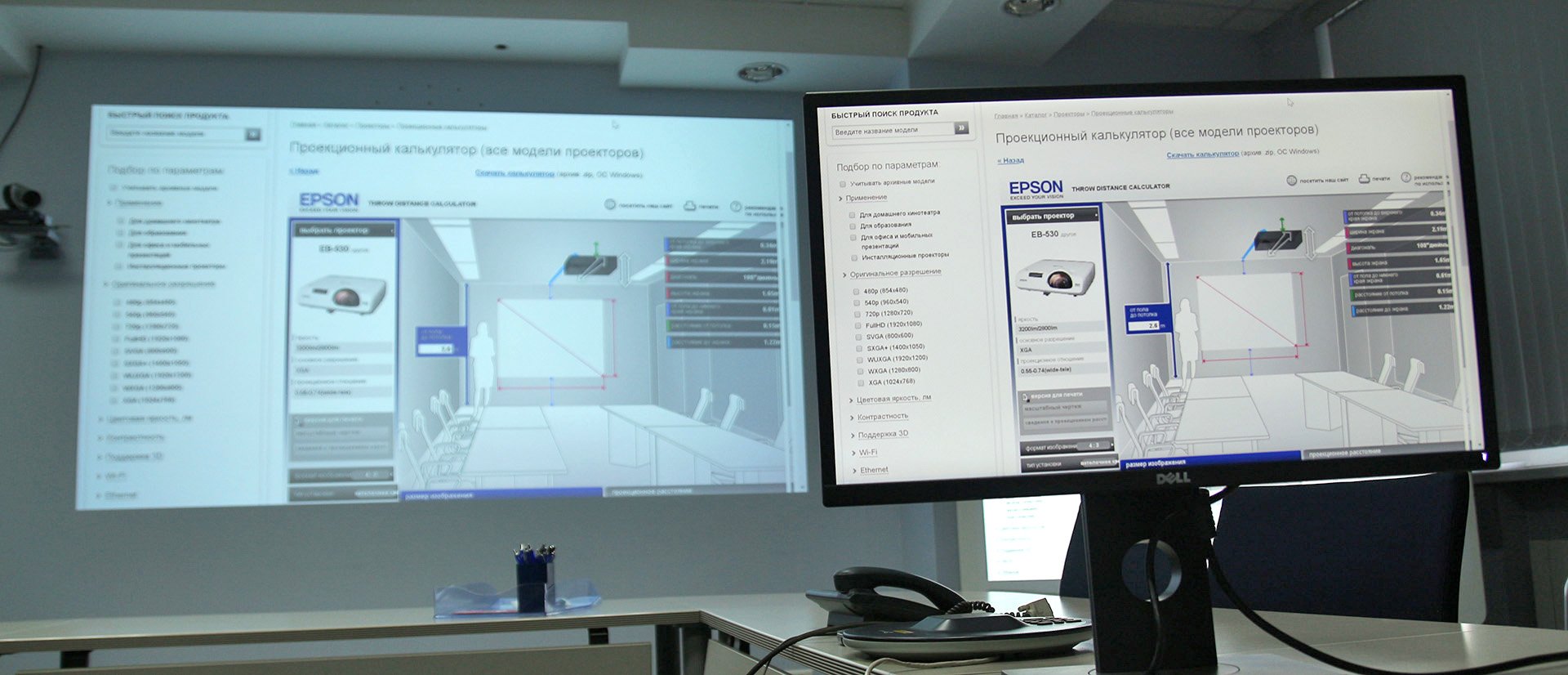
For people with perfect vision, these images will be identical (in definition and size), but the viewer with vision -1 will immediately feel the difference: small text on the monitor will be seen well, and the projector will have to strain and squint to consider it (speech about plain text, for example, from news sites or Wikipedia). The above picture shows that the camera has focused on the monitor (close), and therefore the distant image was out of focus. This is a clear demonstration of how people with myopia will see it (albeit a little more than -1).
In general, the farther from the screen - the worse such a viewer will distinguish the details of the image.
This is not corrected by either contrast or higher resolution. With a constant distance of the screen, the visibility of the text will depend only on the size of the image . Of course, if the brightness is adequate: too low brightness will make the image completely non-contrast and, of course, also affect the reduction of readability of the text.
Two things are more or less constant in the classroom, classroom, meeting room, conference room and similar premises - the location of the wall on which to project (fix the panel, set up an interactive screen) and visitors' places. Obviously, to improve the intelligibility of the image, you can only increase its diagonal - this is the only way.
And here is a vivid example from our large meeting room: 68 inches vs. 123 inches from a distance of 6 meters:

The image is projected by an ultrashort- focus interactive projector ( link 1 , link 2 ) Epson EB-1460Ui and an “ordinary” (or “universal”) Epson EB-1985WU suspended from the ceiling. Brightness - 4400 and 4800 lumens, respectively. It is clearly seen that the image of the EB-1460Ui is slightly overexposed in the image - it is too close to work with such brightness in this frame. In order to somehow lower the brightness, I had to turn on the lamp economy mode and the most accurate color mode (but with such a margin it can work perfectly well in a very brightly lit room!) .
And, yes, that is exactly how these diagonals correlate when viewed from 6 meters.
But how does a 4: 3 image and a diagonal of 156 inches look like compared to 68 inches? It is projected by a short-focus Epson EB-530 (3200 lm) placed under the table (another “old” model):

Since this projector has an XGA (1024 × 768) resolution, the aspect ratio is 4: 3.
By the way, this is a very convenient format for the educational sphere: this aspect ratio is similar to a sheet of paper and allows you to place more text. True, in our negotiation the bottom of the screen in this case is blocking the table. Another problem is the need to adapt to devices with a more familiar 16: 9 and 16:10 format.
From six meters this image looks like this (on a small screen, which in our country acts as an “LCD panel”, now also 4: 3 format, 56 inches diagonal):

Of course, the XGA projector can operate in 16: 9 mode and receive a 1080p signal. The diagonal in this case drops to 143 inches (image height decreases):
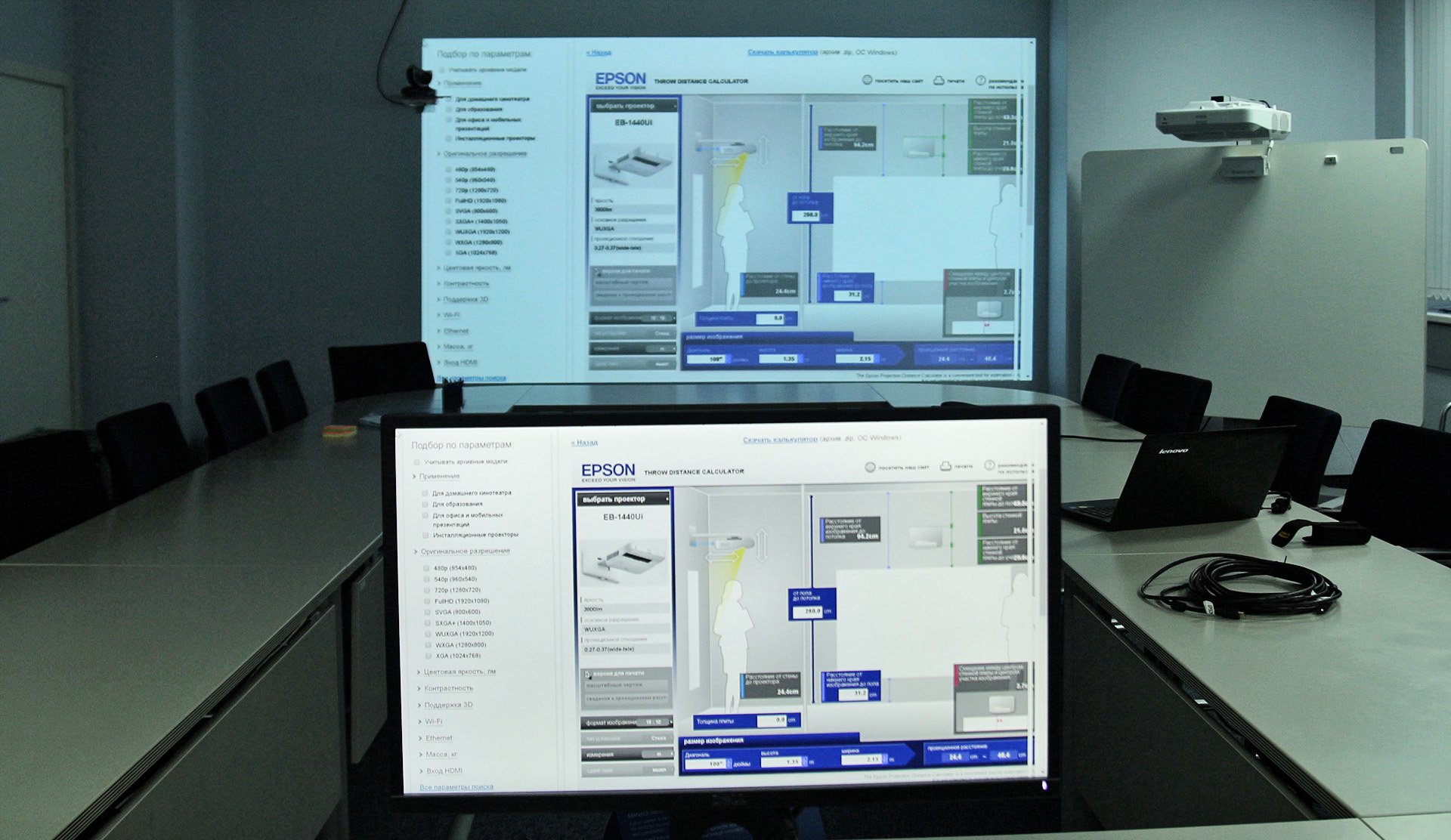
In this picture from the eyes to the monitor is 129 cm, to the wall - 8 meters .
In the case of projecting a 143-inch image, the 3200 lumen of the EB-530 projector is not enough for an illuminated room - the light had to be reduced to a minimum (it also affects the bluish-gray color of the wall itself). In order to get a high-quality image with such a diagonal, it is desirable to use a projector for 5000 lumens or more.
By the way, models up to 5,000 lumens (with the exception of ultrashort-focus, designed for installation on a wall mount) are very mobile. Although even installation projectors with brightness from 5,000 to 25,000 lumens can be considered quite mobile relative to the diagonal of the image projected by them, which can reach 500 inches.
Again about technology features
Since the question of brightness was raised, a few words will have to be said about “intraspecific competition”. Epson has a well-known advantage over other manufacturers of projectors - this is a three-matrix 3LCD technology, which provides a higher light utilization efficiency than single-matrix projectors.
Since it is possible to extract more lumens from lamps of the same power, Epson wins the brightness / image quality combination. In other words, the maximum claimed brightness of the projector can really be used when viewing , without switching to a less bright, but more accurate mode (see also about color brightness ).
Do you have perfect vision?
But back to the legibility of the text. When they talk about good vision, I remember the Japanese pilot-al Saburo Sakai, who learned to see the stars in the daytime.

Perhaps very few people in our time can boast of such excellent vision - the conditions of modern life contribute to the development of myopia, which has already been called the “plague of the 21st century”: from the exclusion, this visual dysfunction gradually turns into a normal state.
If we are talking about a noticeable, but weak myopia (-1), then many do not resort to its correction in general: "and so it is normally visible . " Others wear weaker glasses - following the belief that they are training in sight or for some other reason that they can only understand.
Since all these people will be sitting at your presentation , hardly a demonstration of four Excel tables on one 4K-screen would be a good idea (And it looks so tempting - 4 tables, each 1920 × 1080!) ...
For example, we mentioned the 4: 3 aspect ratio . Anyone who is well aware of the specifics of presentations in a large room will not look down on projectors with a resolution of even 800 × 600 (SVGA), because it can be said to be a good natural constraint that prevents the use of too small objects and fonts in the presentation. Nevertheless, this permission is quite enough to, for example, display the periodic table of the school textbook. It is likely that the real clarity of vision for those sitting in the back rows will not be higher than what such a projector can display.
"I can not see. But I will not shout about it at the whole hall! ”
When during the report there are problems with the visibility of the contents of the presentation, unfortunately, one does not have to rely on the audience response. Most likely, people are ashamed to admit that they are not visible. And, as a rule, only part of the content is poorly distinguishable (a picture is visible, but a comment or a table is not visible on the same slide). As they say, "nothing terrible."
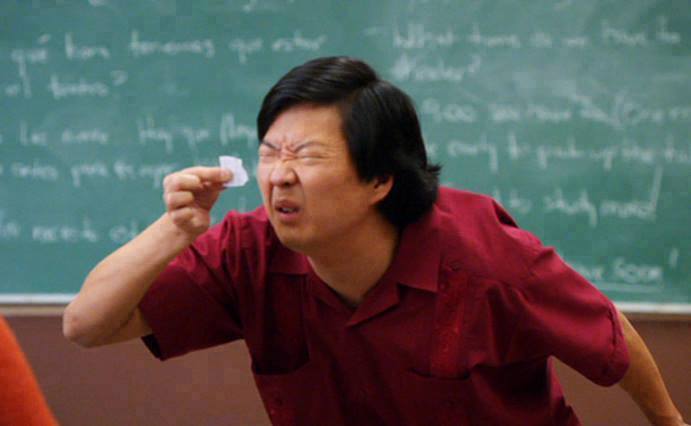
There is “only” that, it turns out, you made this inscription only for 50% of viewers (for example). If the text is on the frontier, then the viewer will have to overextend in an attempt to read it and, quite likely, will not keep up with the pace of the speaker, otherwise he will decide to “score” and put his phone in the phone.
Well, how many all sorts of problems can be associated with poor eyesight in school - and not to list! A shy schoolboy can spoil his progress and kill interest in a subject by simply setting him back a couple of rows, where he will not have time to disassemble the task conditions from the blackboard (or screen).
In order to solve this problem, in large conference rooms they use hanging panels that duplicate the image for the back rows. They are quite large, but they are still located far from the viewer, which also does not completely solve the problem, and we have previously demonstrated that in order to maintain the field of view, like a 23-inch monitor, you need a diagonal of 123 inches when removing 266 cm . And the hanging panels diagonal is clearly not 123 inches .
In general, our recommendation is simple - if possible, strive for the largest diagonal to ensure the best perception of your information to the entire audience .
For example, in the aforementioned section of our website , the following reference table is proposed to determine the optimal screen size depending on the size of the room:
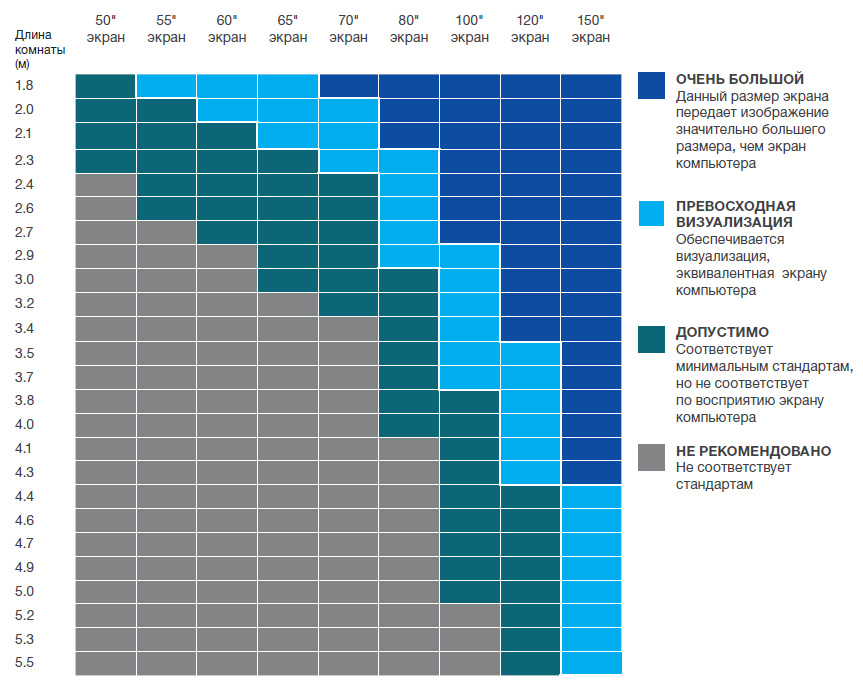
Guard your visual acuity (or reason number 2)

It is time for scary stories
The main character lived in the apartment, went to work (to school), watched TV, sat at the computer, looked at the phone, read books. In general, he was engaged in various “unhealthy activities”. And one day ... His vision deteriorated!
But the oculist warned: “Watch no more than one“ Naruto ”series per day!” Have you ever seen people who were able to comply with these inhuman recommendations?
The story, in general, is vital, because focusing on objects close by is always a strain on the eye muscles. And the task of the muscles is to increase the optical power of the lens (collecting lens) by stretching it. Since we are constantly looking at close objects, the eyes are strained so much that “accommodation spasm” (false myopia) can happen.
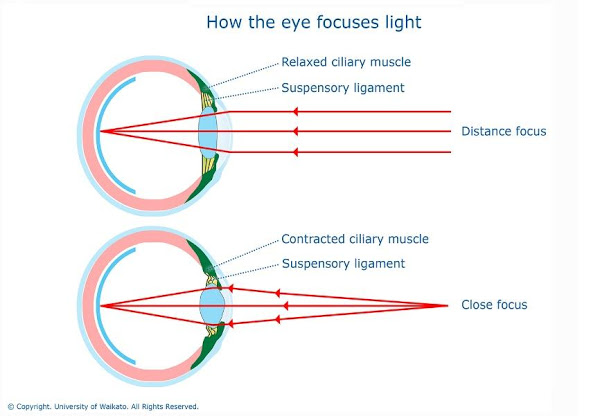
You yourself can see this. Just stand 30-40 cm away from the window opening, look at the frame or wall, and then move your eyes to the window. You will immediately feel how your eyes relax when you look "into the distance."
You can even take it as a rule (read: set a reminder) periodically during work to do an exercise on the "look into the distance on the street" - this helps to relax the eye muscles, which already did not hope to get a long-awaited rest. At first, such relaxation can cause a sudden sensation of discomfort in the eyes (which is not surprising after long work in tension).
Entertaining optics
Let's try to figure out to what degree the focal distance affects eye strain. The reports of ophthalmologists periodically meet the following schedule:
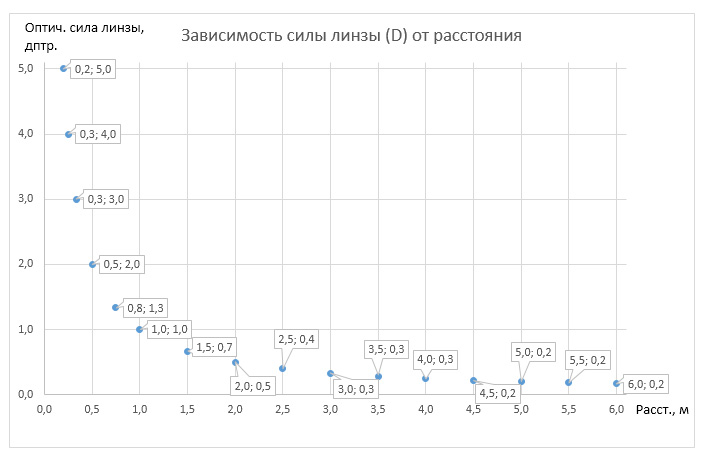
The bottom line is this: the optical power of the lens (D, diopters) is 1 / distance . When looking at "infinity", the eye rests. When focusing on objects near it, it must change the shape of the lens in order to achieve a greater number of diopters.
At a distance of 2 meters or more, only a minimal change in optical power is required from the eye. If we assume that “eye load” or “eye fatigue” is proportional to the required optical power, then the following is obtained:
- when viewed from a distance of 1 meter, twice the voltage is required than when viewed from a distance of 2 meters;
- when viewed from a distance of 50 cm - 4 times larger;
- viewing from 2 meters instead of 4 will increase the load only 2 times (it is still noticeable, but not so critical);
- the load on the eyes when changing the viewing distance from 8 meters to 0.5 meters increases 8 times (this is how to compare dumbbells by 5 kg and 40 kg)!
The projectors here are a real salvation, because they allow you to very and very significantly move away from the screen - even 2 meters is considered a close distance, and 4 meters with a projector is not a problem! Many film fans prefer to watch movies from 4 meters.
Using a projector, you get the opportunity to significantly reduce the strain on your eyes while watching a movie or playing games. Today there are bright laser projectors, such as the Epson EH-LS100, which is placed close to the wall. While they are, frankly, not cheap, but sharpened specifically for intensive everyday use in a lit room (due to the high brightness and impressive resource of the laser light source).

At the same time, using the projector in a home theater and as a replacement for a TV is still a bit different task. In complete darkness, we strive to pick a model more contrast and do not need so much an excess of brightness. In low-light conditions, the image quality is provided by the brightness reserve — here, the characteristics of the most inexpensive Epson projectors can be close to or even exceed the flagship home theater models. Projectors such as the Epson EH-TW610 or EH-TW5400 are excellent for these conditions due to the combination of good image quality and high brightness.
Not all projectors are equally useful.
On the market of the most accessible devices there are single-matrix projectors (DLP, for example) and three-matrix (3LCD-projectors in our case).
We are talking primarily about the "lamp" models, since so far models with LED RGB light sources do not approach them in any of the characteristics at the same price .
So, single-matrix projectors do not project a finished color frame onto the screen, and 3LCD-projectors project them. The user easily detects this difference by running his eyes over the contrast image — if a bright object is followed by a subtle, fleeting color train, then we have a one-matrix projector.
Manufacturers are trying to minimize this effect on home projectors with the help of the six-segment “RGBRGB” color wheel.

Through this rotating wheel, one-matrix DLP projectors in turn project multi-colored pictures, but we usually do not notice this. But our visual apparatus, which should summarize it and present it to us in the form of a finished color image ... who knows? There was even a study that this, in fact, affects fatigue.
But the manufacturer “knows better” that the aforementioned “rainbow effect” interferes only with those who buy a projector for the house. Otherwise, why put the “RGBRGB” wheel only on home projectors ?
Oh yeah, that's why: they put wheels on office ones that allow to increase brightness - in addition to “RGB” (red, green, blue) they also put yellow, blue and ... transparent (white). This allows you to raise the brightness, but the "rainbow effect" becomes more noticeable - the flickering of successive bright colors becomes more and more noticeable to the eye. There's nothing you can do: you want more brightness with one matrix - either take the lamp brighter, or make the transparent segment wider.
It also makes it possible to understand why RGBRGB wheels usually produce a green image at maximum brightness , while other types of wheels have weak, dull colors . Told about it quite recently in the next post .
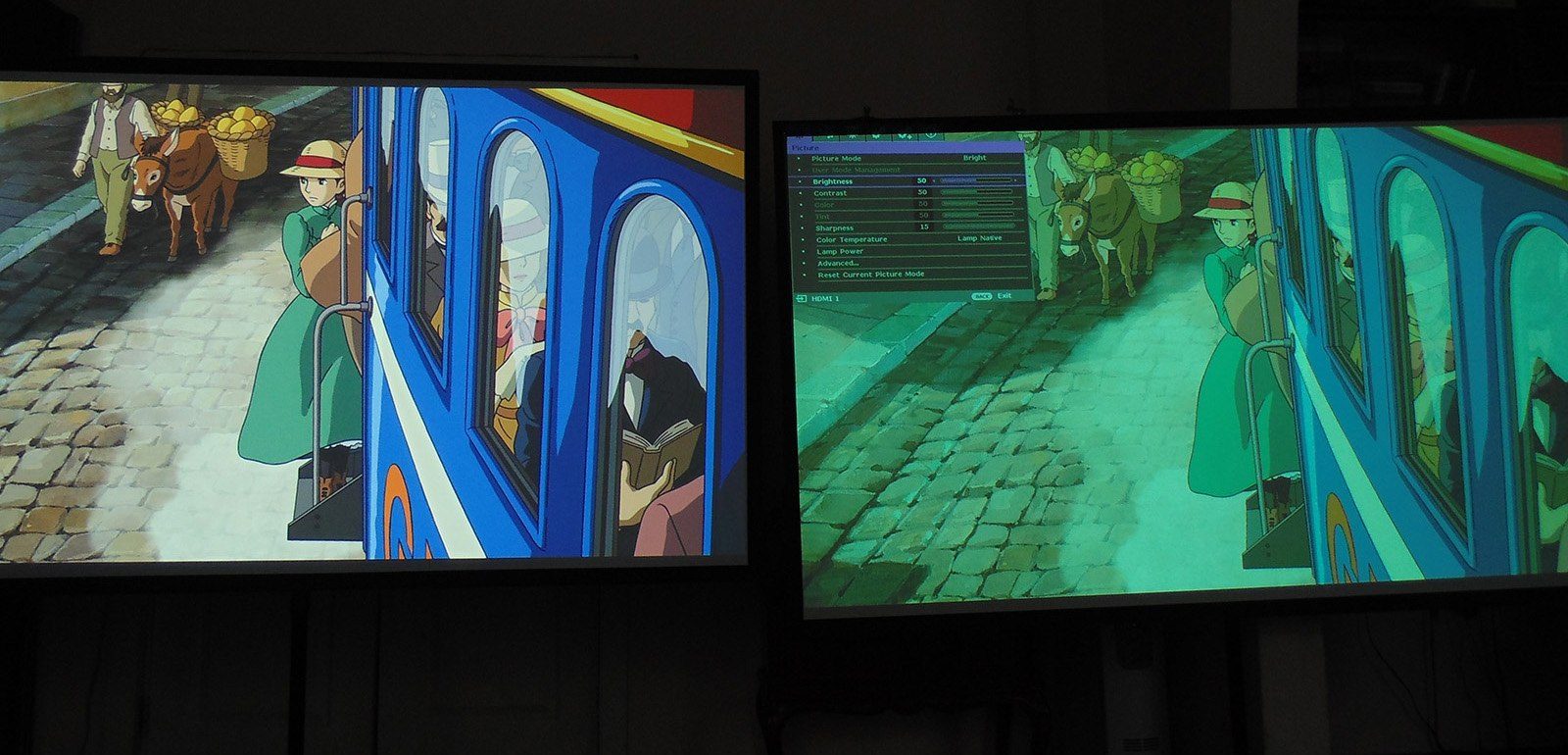
In general, this trend of filling the image with "green paint" instead of discoloration, aimed at the formal achievement of passport brightness, which we have been seeing recently, is a separate topic for conversation.
Conclusion
I stayed away from the working monitor. And you?
Without spreading my thoughts on the tree, I will fix everything mentioned in the post. Among the advantages of the projector as an image display device in an office, school or audience we have:
- the ability to achieve the greatest diagonal of the image (for the same money), using an acceptable color mode (and not sharpened only under formal brightness) image mode;
- larger diagonal means better legibility of the text;
- a large diagonal means being able to stay farther from the screen — useful for maintaining vision;
- higher brightness also means better picture quality in a lighted room, and also allows switching to a quiet economy mode with the least loss in a darker one, respectively;
- three-matrix projectors based on 3LCD technology do not have a “rainbow effect”. The image is formed in a more natural way.
We believe that this gives projectors an edge over other display devices, including televisions and LCD panels, especially in business and education.
